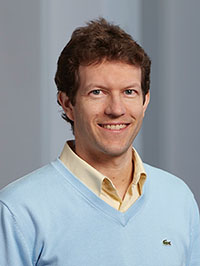Prof. Dr. Adrian Perrig

Prof. Dr. Adrian Perrig
CAB F 85.1
Universitätstrasse 6
8092 Zürich
Phone: +41 44 632 99 69
E-Mail: adrian.perrig@inf.ethz.ch
Our main project is on the SCION secure Internet architecture.
We have founded Anapaya Systems, a startup to commercialize SCION technology.
We have founded Anapaya Systems, a startup to commercialize SCION technology.
Publications
by Haowen Chan, Mark Luk, and Adrian Perrig
Abstract:
Sensor network localization continues to be an important research challenge. The goal of localization is to assign geographic coordinates to each node in the sensor network. Localization schemes for sensor network systems should work with inexpensive off-the-shelf hardware, scale to large networks, and also achieve good accuracy in the presence of irregularities and obstacles in the deployment area. We present a novel approach for localization that can satisfy all of these desired properties. Recent developments in sensor network clustering algorithms have resulted in distributed algorithms that produce highly regular clusters. We propose to make use of this regularity to inform our localization algorithm. The main advantages of our approach are that our protocol requires only three randomly-placed nodes that know their geographic coordinates, and does not require any ranging or positioning equipment (i.e., no signal strength measurement, ultrasound ranging, or directional antennas are needed). So far, only the DV-Hop localization mechanism worked with the same assumptions \citeNicNat01. We show that our proposed approach may outperform DV-Hop in certain scenarios, in particular when there exist large obstacles in the deployment field, or when the deployment area is free of obstacles but the number of anchors is limited.
Reference:
Using Clustering Information for Sensor Network Localization. Haowen Chan, Mark Luk, and Adrian Perrig. In Proceedings of the IEEE Conference on Distributed Computing in Sensor Systems (DCOSS 2005) 2005.
Bibtex Entry:
@InProceedings{ChLuPe2005,
author = {Haowen Chan and Mark Luk and Adrian Perrig},
title = {Using Clustering Information for Sensor Network Localization},
url = {/publications/papers/clusterlocalize.pdf},
booktitle = {Proceedings of the IEEE Conference on Distributed Computing in Sensor Systems (DCOSS 2005)},
year = 2005,
month = jun,
abstract = {Sensor network localization continues to be an
important research challenge. The goal of
localization is to assign geographic coordinates to
each node in the sensor network. Localization
schemes for sensor network systems should work with
inexpensive off-the-shelf hardware, scale to large
networks, and also achieve good accuracy in the
presence of irregularities and obstacles in the
deployment area. We present a novel approach for
localization that can satisfy all of these desired
properties. Recent developments in sensor network
clustering algorithms have resulted in distributed
algorithms that produce highly regular clusters. We
propose to make use of this regularity to inform our
localization algorithm. The main advantages of our
approach are that our protocol requires only three
randomly-placed nodes that know their geographic
coordinates, and does not require any ranging or
positioning equipment (i.e., no signal strength
measurement, ultrasound ranging, or directional
antennas are needed). So far, only the DV-Hop
localization mechanism worked with the same
assumptions~\cite{NicNat01}. We show that our
proposed approach may outperform DV-Hop in certain
scenarios, in particular when there exist large
obstacles in the deployment field, or when the
deployment area is free of obstacles but the number
of anchors is limited.}
}